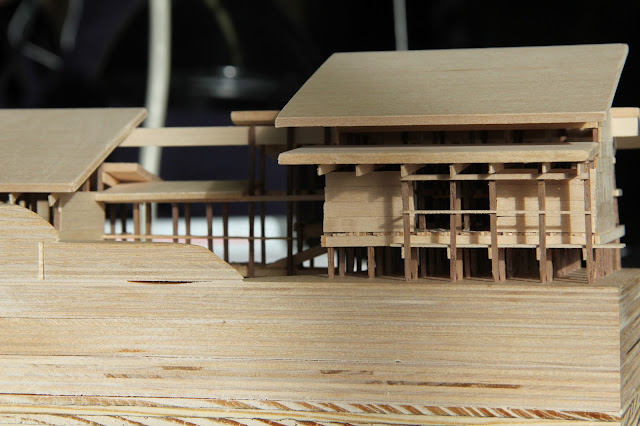
--
The Shinto Shrine for Jiro Yamamoto sets a modern standard to the ancient tradition of Shinto Shrines. The delicate foundation stands like a Praying mantis on 120 legs above the fragile soil and rock below. This shrine protects the earth and waterfall used in the ritual of ablution. The ritual for Shintoism is the act of cold water ablution. Jiro’s experience was synonymous with this act or rite of passage.
1. Run2. Spirit Shake
3. Pray
4. Deep Breathing
5. Enter Cold Waterfall
6. Cleansed
7. Tea Ceremony
Program Menu:
Public Worship hall: Haiden
Morning Prayer
Chant
Gohei Bell
Lucky Note
Private Offertory Hall: Heiden ishi-no-ma
Offering of Prayer
Offering of Music
Offering of Paper
Offering of Food
Private Tea Room: Sadau
Afternoon Tea Ceremony
Clothing Room
Wood Room
Fireplace Tea Storage
Private Sanctuary Bridge: Honden
Cold Water Ablution
Deep Breathing
The Shinto Shrine on Lake superior acts in accord with social, economic and environmental stainability.
Like a Praying Mantis, Gently standing above a flower, the Shinto Shrine delicately stands above the land as if it were on toothpicks. Only metal bolts ever enter the rock below, which supports the structure.
The roof structure furthers the protection of the land and the building.
The sun enters the clerestory only during the colder seasons. Missing tree leaves and low sun angles allow this to occur.
With the ceremony of Tea, the room is only heated during time of use. The furnace is fueled by wood found on the forest floor: a fully sustainable practice.
The summer months are cooled by the waterfall spray, wind through the open walls and shaded overhangs.
During the winter months a ‘coat’ covers the building by simple screw on walls.
Maple trees are purchased well priced and locally in Michigan and Wisconsin. Trees are a natural and fully sustaining material unlike the poly- materials.
Teak wood is used for the water soaked bridge to prolong its lifetime. Water does little to rot Teak wood. It has been used on sailboats for many decades.
The delicate nature of construction, the cheap price of wood, the high detail design, great community project, and the local beauty of the waterfall makes the Shinto Shrine a sustainable building which will last for a very long time.
--











